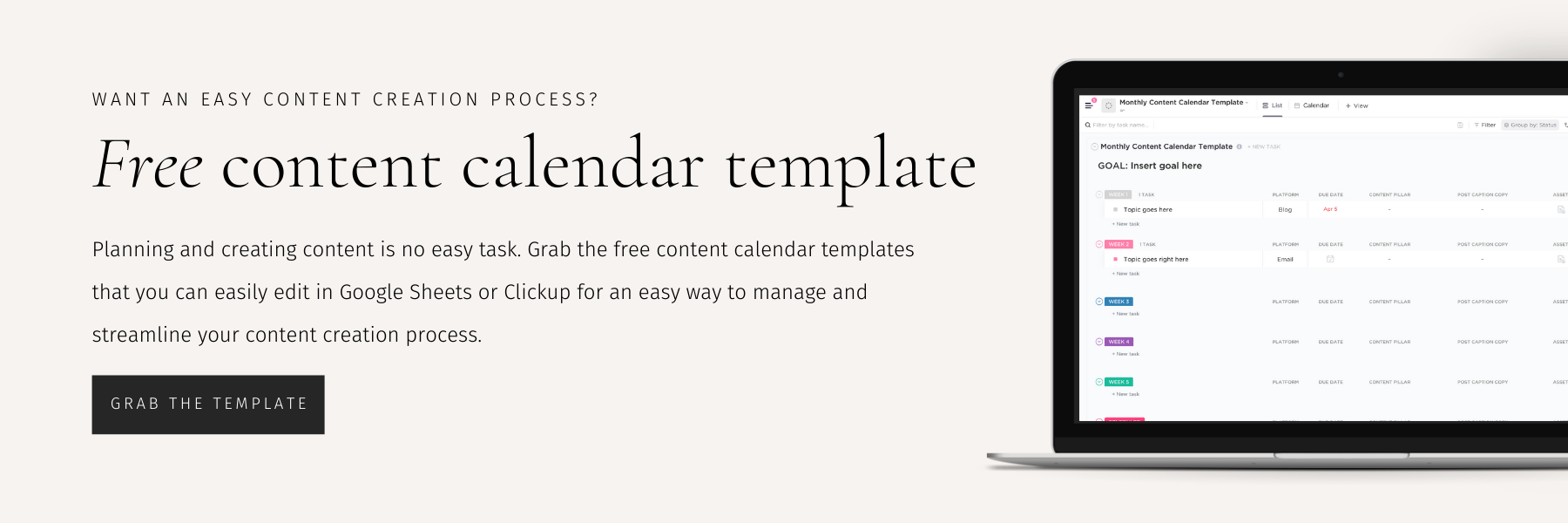Developing a winning content strategy feels overwhelming at first, but when you simplify it you can remove the overwhelm from the process and create a much more effective and efficient content creation process that makes it easier for you to get your message out there.
When you spend time writing, editing, scheduling, and producing content for your brand, you want to make sure that it is actually doing its job or you will end up wasting all that time. My simple 3 step content creation process allows you to create regular content easily while keeping the bigger picture in mind so that it actually works for your brand.
This is for you if you:
- Struggle to create consistent content
- Need a more streamlined process
- Want your content to connect more with your brand

Step 1: Map out your strategy
Like I always say, you want to start by thinking about the strategy because everything you create needs to be backed by strategy. I suggest mapping out your content by quarters and months. I like to think about the overall goal and sales focus of the quarter first and then break that down by month so that it doesn’t feel so overwhelming but you are still working towards your bigger goals.
I use a system in Clickup to map out each month that includes topics for blog posts, emails, social media, and special promotions for each day of the month. I also have “themes” for each day to make sure that I am sharing the right amount of authority content and connection content.
Once you set your goal and focus for the month, start by writing in any promotions that you know you’ll need to talk about on certain days. Then determine what your blog or podcast topic will be for each week. I use my blog as my big piece of content each week and then use that blog post to generate related content for emails and social media so figuring those out first helps me map out the rest of the content.
After blog posts, I fill in the email and social media topics based on that blog post and the daily themes I have set. Once I have the whole month mapped out, I batch write the content by week.
I also recommend creating a content library and topic bank so you can easily reuse and repurpose content. I use the content library as a way to store social media posts that I know I will want to use or reference again later. I use the topic bank as a way to track topics that I want to talk about for future content. Both of these will make it much easier for you to fill in your marketing calendar and write content because you have a starting point.
Step 2: Write and produce the content
Now that you’ve mapped out your content for the month and you know what you need to write, you can batch write your content for easier content creation. By doing this, you’ll be more likely to get in a flow of writing and be able to produce your content quicker. Plus, since you’ve already taken the time to strategically think through your content, you won’t end up staring at a blinking cursor and can hit the ground running on your writing instead.
Start by writing those key content pieces (blog posts, emails, podcasts – whatever it may be for you) and then use that content to create your smaller items (like social media posts) based on what you already laid out in your marketing calendar for the month.
I also use this step to produce assets that go with the content like videos and graphics.
Step 3: Implement and engage
After you have all your content written and produced for the month you can then shift to scheduling, posting, and engaging. Whether you do this yourself or hire it out, I do recommend setting aside some time to batch schedule your content to make it easier and give you more time to focus on engaging.
I recommend Planoly and Flodesk for content scheduling but there are tons of tools out there that can help make this process even easier.
Start by gathering images, videos, or graphics you need, then set up and schedule your content for the week or month ahead. Now your content is ready to post each day and you can focus on engaging with your audience on the topic each day.
Don’t skimp on this part because engaging with your audience and your content is just as important as the strategy behind it. It won’t do any good to put in the time mapping out all of your content and writing all those posts if you don’t follow through.
Bonus: Utilize marketing campaigns
If you struggle coming up with marketing content and just don’t know what to say or where to say it, a marketing campaign might help you make more sense of it. A marketing campaign is essentially grouping together your marketing efforts towards one goal or message. Instead of sharing random content all the time, you are focusing on one core message that more than likely leads to one core offer.
To create a marketing campaign you would block off a certain amount of time on your calendar to run this campaign, choose the topic, and center all of your marketing around that topic. For example, you might run a different marketing campaign every quarter.
For that quarter, most of your social media posts, blog posts, emails, podcasts, or videos would relate to that marketing campaign topic. It can be different styles of content but all would be related to the same topic. The goal is to create relevancy and build on your content so that you attract your audience to your current offer.
For service-based businesses, this can be done to highlight different offerings at different times based on your booking calendar. For product-based businesses, this can be done for seasonal campaigns or collections of products that you are launching.
The goal of this style of marketing strategy is to make it easier for you to create content on the back end and for your audience to consume the content on the front end. Instead of sharing a random variety of content all the time, you are focusing on one thing at a time and it allows people to really dig deep into it with you.
Regardless of your content creation process, the key is to make sure that you are strategizing in relation to your brand strategy. Your content is an extension of your brand strategy and it’s the way that you communicate your message.
You want to be sure that you are sticking to your brand and using the right voice, positioning, and messaging when creating your content calendar so that your content is actually working to build your brand.
Recap
Content creation can easily be overwhelming and time-consuming. But an easy process that focuses on the strategy behind your content is the best way to streamline the process and get more out of it.
Next Steps
Download the free content calendar template for Clickup or Google sheets to make your content creation process a little easier.
Save this article
Enjoy this article and find it helpful? Pin this image on Pinterest so you’ll always have this info on hand!








